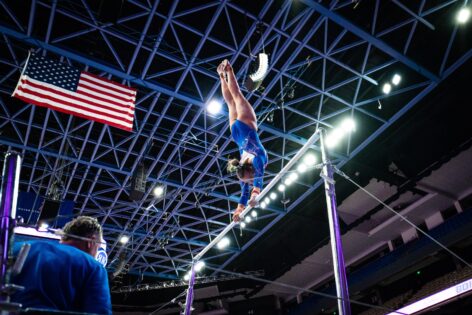Under the fluorescent lights of the NOW Arena, where ambition meets calculation on four-inch beams and polished floors, the 2025 U.S. Classic should have carried a sense of promise. After all, it was the final stop before the U.S. Gymnastics Championships. A chance for Olympic returnees and rising hopefuls to draw clear lines around their form. Yet, as routines unfolded and scores were tallied, the atmosphere online turned irritable. Fans didn’t wait for the closing rotation to express what had been bothering them since the broadcast began. The gymnastics may have been elite. The coverage was anything but.
It was only in the meet’s closing chapters that the mood began to ease, thanks largely to the unexpected brilliance of 16-year-old Claire Pease. While others stumbled, most notably Hezly Rivera, whose beam and bars routines fell apart under the pressure, Pease emerged steady and unshaken. She finished top-three on every apparatus, collecting a 54.600 in the all-around and pushing past seasoned contenders. With Olympic veteran Simone Biles observing quietly from the floor, Pease’s composure did not falter. As Simone Rose entered the final rotation with a narrow edge, Pease delivered a 14.050 on vault, surpassing Rose’s lower-difficulty floor routine and seizing the win. But even such vibrance could not hide the broadcasting loopholes.
From commercial-split interruptions to camera angles that missed crucial landings, NBC’s broadcast of the Classic appeared unable. Or perhaps unwilling to capture the meet’s pacing and energy. Viewers sounded off with irritation, baffled that elite gymnastics still lacks the clarity and structure long since perfected by NCAA broadcasts. While some longed for the NCAA-like split screen, others bemoaned watching only a handful of routines before being dropped into yet another commercial break. The issue wasn’t just about visibility, but recognition. Afternoon sessions were brushed aside as though their athletes were an afterthought. That indifference did not go unnoticed. Fans also seemed irritated with the over exposure that the coverage provided to Simone Biles.
The presence of Biles, standing just off the mat and declining media obligations, offered another layer of intrigue to the evening. She did not compete. She was not honored. And yet, her silent encouragement toward Roberson and Caylor was unmistakable. In her absence, the spotlight drifted, however briefly, to the next tier of gymnasts learning to carry themselves without the weight of a legacy. It was Pease who capitalized on the moment, shifting the conversation from coverage frustrations to performance.
Claire Pease (Image Credit: Instagram/@clairepease)
Nevertheless, fans are unlikely to forget the broadcast’s shortcomings. The athletes delivered routines shaped by months of repetition and stress, only to have their work filtered through a production that seemed more invested in familiarity than fairness. And while Claire Pease’s rise deserved the attention it ultimately received, many are left wondering what stories they missed along the way. Routines clipped for commercials, efforts sidelined by scheduling, and names never mentioned on air. For a sport that depends on detail, the coverage fell short of its subject. And fans online did not like it at all.
Fans bash U.S. Classic broadcast for sidelining athletes and spotlighting everything else
As soon as the coverage ended, fans flocked to the internet. NBC’s disregard for the earlier sessions didn’t sit well with fans. One noted, “Yo, @NBCSports, the athletes who competed in the afternoon are also part of the standings.” Despite all competitors being eligible for the same podium, those who performed outside prime hours barely made it to screen time, implying a hierarchy in coverage that didn’t exist in the scores.
Hezly Rivera’s unraveling beam and bars routines exposed the brutal cost of elite preparation. The comment, “Uneven Bars, wonky routine construction, tkatchev, and exhaustion vs. USAG,” captured that sentiment. It wasn’t just about an off day—it pointed to a systemic mismatch between scheduling, routine design, and readiness, all of which the broadcast failed to contextualize.
As Rivera’s tough meet played out, the on-air team offered a dismissive “It is a rough day for Hezly.” A fan bit back with, “It’s a rough day for all of us, me thinks…”—frustrated by the lack of depth in commentary. For a gymnast visibly unraveling under pressure, viewers expected more insight, not a one-liner that glossed over real struggle.
Simone Biles stood silently on the sidelines, supporting teammates but steering clear of interviews or ceremony. Still, the cameras clung to her, even diverting to off-topic visuals. One fan asked, “Was showing photos about her personal life when she’s not even competing really necessary?”—a fair criticism of how airtime was allocated while live routines went untelevised.
NCAA broadcasts have set a new bar in gymnastics media, yet the U.S. Classic remains stuck in outdated formats. “Why don’t elite meets use the split screen coverage that NCAA uses?” asked one viewer. Their point stood—elite fans are now accustomed to seeing more, not less. But NBC’s one-apparatus-at-a-time model kept them guessing what they were missing.
The flow of competition was routinely broken, disrupting both rhythm and immersion. A fan summed it up plainly: “Forgot how much I hate non-NCAA coverage.. 2-3 routines, 2 min commercial break, repeat.” This pattern left audiences disengaged, feeling like the broadcast was selling ads, not storytelling athletic excellence. Thus, with things looking quite grim, it remains to be seen what happens next.
The post Claire Pease, Joscelyn Roberson & Co Shined While Fans Sounded Off as Multiple Issues Undermined U.S. Classic Experience appeared first on EssentiallySports.
